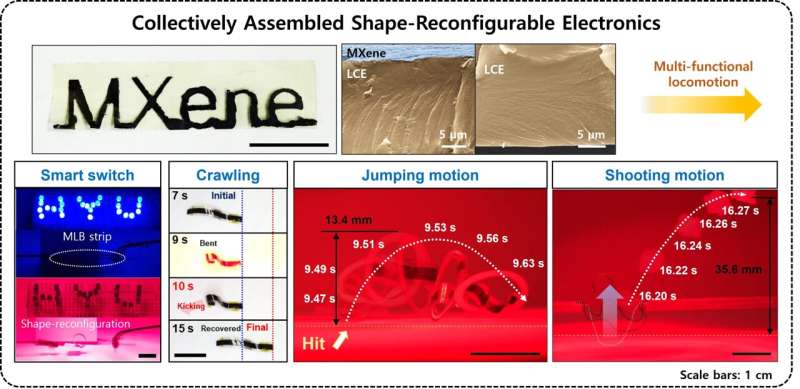This article has been reviewed according to Science X's editorial process and policies. Editors have highlighted the following attributes while ensuring the content's credibility:
fact-checked
peer-reviewed publication
trusted source
proofread
Study demonstrates on-demand locomotion of physical intelligence–encoded electronics

Beyond flexible electronics, which can be deformed into 3D curvilinear shapes through passive mechanical strain, shape-reconfigurable electronics hold significant promise as the next generation of electronic devices.
As electronics continue to miniaturize, spatial limitations hinder passive mechanical deformation, necessitating physical contact and the inclusion of bulky, heavy power sources like batteries. To address the intrinsic limitations of miniaturized systems, the materials used in shape-reconfigurable electronics actively respond to external stimuli, such as temperature, light, and electricity, and execute programmed actuation.
These materials, referred to as stimuli-responsive materials, can be considered as having 'physical intelligence' encoded within them. These physically intelligent materials serve as a platform for shape-reconfigurable electronics, as they can actively transform their shape into various 3D forms and change their body position through reversible actuation.
Led by Jeong Jae Wie, an Associate Professor in the Department of Organic and Nano Engineering at Hanyang University, researchers have introduced a novel concept of physical intelligence-encoded liquid crystal elastomer-based shape-reconfigurable electronics, which have demonstrated on-demand locomotion, including crawling, jumping, and sling-shooting small objects.
One of these promising physical intelligent materials is liquid crystal elastomer (LCE), a material well-known for its application in liquid-crystal displays (LCDs). Beyond its use as display material, the programmable alignment of anisotropic liquid crystalline molecules enables direction-controlled shape reconfiguration, expanding its potential as a platform for shape-reconfigurable electronics when LCE is combined with other conductive fillers.
In this study, published in Nano Energy, the research team successfully integrated LCE with a highly conductive Ti3C2Tx MXene, forming a bilayer structure. MXene belongs to a new family of 2D materials known for their remarkable electrical conductivity and high photo-thermal conversion efficiency.
Through a customized in-situ photopolymerization process, MXene was effectively transferred to the LCE layer without any damage or physical delamination.
The MXene layer has a thickness of 370 nm which is 133 times thinner than the LCE layer, resulting in low bending stiffness for the bilayer and enabling high actuation performance. Moreover, the newly-formed LCE/MXene bilayer, named MLB, exhibits remarkably high electrical conductivity of approximately ~5,300 S cm-1, enabling the MLB to power LEDs. The MLB also demonstrates photo-/electro-thermally driven actuation capabilities under near-infrared light irradiation and with voltage applications of less than 3.5 V.
To achieve diverse shape-reconfiguration and locomotion with MLB, collectively assembled structures were introduced, taking the symmetricity of assembly into account.
Symmetrically assembled MLBs demonstrated S-, W-, flower-like shapes, and inverse-chiral structure. Furthermore, asymmetrically assembled MLBs showed directional crawling and rotation with adjustments to the length and molecular alignment of the constituent MLB units.
The asymmetrically assembled MLBs featured a continuously shifting center of mass during their actuation, leading to directional locomotion. Inspired by snap-through instability, these assembled MLBs also accomplished jumping motion and sling-shooting of small objects. For this, the research team newly introduced a rigid paper frame and an alternatively assembled structure, which artificially constrained shape-reconfiguration of the assembled MLBs and then effectively stored the resulting elastic energy. This stored elastic energy was then converted into mechanical energy via snap-through, ultimately leading to rapid and explosive jumping and sling-shooting motions by the assembled MLB.
Woongbi Cho, the first author of the paper, notes "Multi-functionality is a key component for next-generation electronics, and geometrical diversity enables shape-reconfigurable electronics to perform multi-modal actuation and locomotion."
Speaking about the MLB, Professor Wie added, "Shape-reconfigurable electronics based on liquid crystal elastomer and MXene successfully extend the application of liquid crystalline polymers. We believe this technique can give insight into form shape-reconfigurable platforms which can be applied in various fields including energy storage devices, antennas, and miniaturized robotic systems."
More information: Woongbi Cho et al, Multi-functional locomotion of collectively assembled shape-reconfigurable electronics, Nano Energy (2023). DOI: 10.1016/j.nanoen.2023.108953
Journal information: Nano Energy
Provided by Hanyang University





















